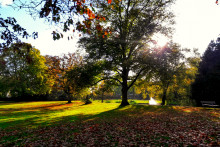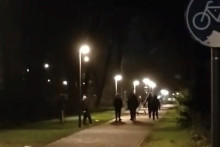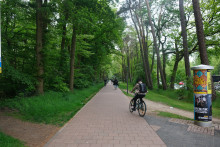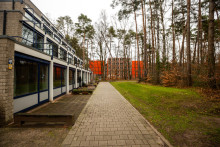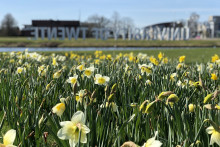The UT campus has a unique feature: its green spaces. Roughly 59% of its grounds are formed by green areas, yet we don’t know much about these ecosystems that we pass every day. Which is why scientists from the Faculty for Geo-Information Science and Earth Observation (ITC) initiated the ‘Green Campus’ project earlier this year. They aim to monitor and assess the green capital of the campus, as well as use the campus as a living lab for testing innovative research methods.
open to all
The Green Campus was started by ITC researchers focused on ecosystem services. The initiative hopes to welcome scientists from all UT faculties interested in green capital. The following researchers are currently involved: Wieteke Willemen, Evangelia Drakou, Nina Schwarz, Anton Vrieling, Iris van Duren, Frank Ostermann.
‘It is not at full speed yet. We are starting small,’ says Wieteke Willemen, one of the ITC scientists working on the research initiative. ‘This year we decided to structurally focus on benefits of the green spaces on campus and we started using campus as a case area in our courses. We have this large piece of land at our disposal, so why not use it.’
‘We want to use the campus as a playground for research’
The project has three main objectives: to monitor, to test and to increase awareness. ‘We are collaborating with the Campus & Facility Management to monitor selected ecosystem services,’ explains Willemen. ‘Secondly, we want to use the campus as a playground for research and test new methods. And lastly, we want to raise awareness about the importance of green spaces. We want to make the UT community proud of our green capital. We are a university of technology, but we should also appreciate nature and processes that don’t involve wires.’
Flora and fauna
The researchers already began measuring some of the benefits of the green capital, explains Nina Schwarz from ITC. ‘We collect data on trees to estimate the carbon stored in trees on campus, because by storing carbon the vegetation helps regulate our climate. We are also measuring cooling effects of green spaces on campus. Using portable temperature sensors and special models, we measure how trees and water bodies influence air temperatures and model their effects for the whole campus.’

On top of that, the initiative will look at recreational use of green spaces. ‘Student and staff living and working on campus, as well as people from the surroundings, use the green areas for sport and relaxing,’ says Evangelia Drakou from ITC. ‘We want to monitor where people go to map the areas that are important for people’s enjoyment.’ The researchers might also look into so called habitat connectivity for selected species. ‘The campus is home to some birds and insects that are very important. We could monitor them and see what the impact could be if we, for example, build a parking lot or a new building.’
New cameras
To see how vegetation on campus reacts to climate change, two webcams were installed on campus this year - one on the Horst tower and one on the Spiegel building. Their purpose is to continuously monitor selected trees and to therefore better understand seasonality of vegetation and if it changes together with the global climate.

Overall, the project can contribute to future policies, thinks Willemen. ‘By better understanding the relevance of green capital, we can improve decision making for new policies. Besides that, we really hope this initiative can create a canvas for people working on topics related to vegetation or ecosystem services and connect researchers from all faculties.’


